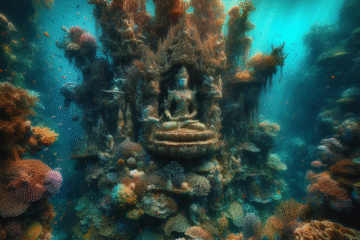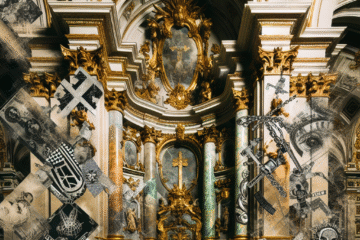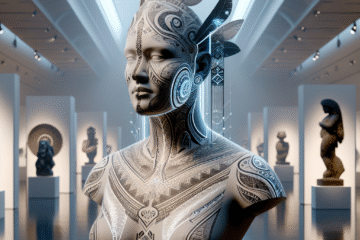Introduction
Humanity’s relationship with art is as ancient as our ability to think abstractly and dream beyond survival. Over tens of thousands of years, visual art has transformed with technology, culture, and philosophy—moving from primitive cave paintings to digital masterpieces created by artificial intelligence. Each era marks a pivotal change, not only in technique and medium but in how we understand ourselves and the world around us. This article traces those transformative epochs, offering a sweeping yet focused view of how visual art has evolved through the ages.
1. The Echoes of Origins: Prehistoric and Ancient Art
The story begins around 40,000 years ago in the depths of caves such as Chauvet in France and Altamira in Spain. These early artworks—hand stencils, hunting scenes, and geometric shapes—were more than rudimentary decoration. They were expressions of belief, survival, and the human urge to communicate across generations. Art in this period served ritualistic and symbolic purposes, often linked to shamanistic practices or the desire to influence the natural world.
As societies settled and organized, art became a public narrative medium. In ancient Egypt, Greece, and Mesopotamia, art immortalized gods, rulers, and myths. The invention of writing paralleled advancements in visual storytelling, and art began to solidify its place as both a reflection of power and a vessel of religious and cultural values.
2. The Illusion of Reality: Classical to Renaissance Art
From the classical idealism of Greek sculpture to the realism of Roman portraiture, the goal became capturing human anatomy and emotion with precision. These ideals were resurrected during the Renaissance, a period of intense artistic flowering from the 14th to 17th centuries in Europe. Fueled by humanism and scientific inquiry, artists like Leonardo da Vinci and Michelangelo explored perspective, anatomy, and light, bridging the gap between spiritual transcendence and corporeal reality.
The development of oil painting, the printing press, and linear perspective revolutionized how art was made and disseminated. The patronage of wealthy elites and religious institutions also shifted the role of the artist from anonymous craftsman to individual genius—a concept that would reverberate through modern times.
3. Shattered Forms: Modernism and the Avant-Garde
The Industrial Revolution and growing urbanization of the 19th and early 20th centuries ushered in the age of Modernism. In reaction to the mechanized, alienating aspects of modern life, artists began to break away from realism. Impressionists like Monet captured fleeting moments of light; Expressionists and Fauves explored inner feeling with bold color; Cubists, led by Picasso and Braque, deconstructed form to express complexity.
These movements were not purely aesthetic—they carried revolutionary ideas about perception, consciousness, and truth. Art became a space for critique and innovation, embodying Friedrich Nietzsche’s call to reinterpret values in the wake of decaying traditions. The avant-garde was a declaration that art need not imitate life but create new realities.
4. The Medium Is the Message: Postmodernism and Digital Art
By the mid-20th century, Postmodernism emerged, questioning the grand narratives of art history. Movements like Pop Art, Minimalism, and Conceptual Art challenged the definitions of art by using consumer culture, industrial materials, and provocative themes. Andy Warhol’s silkscreens of Campbell’s soup cans and Marilyn Monroe forced society to confront the commodification of imagery and the blurred boundaries between high and low culture.
The digital revolution of the late 20th century expanded artistic possibilities exponentially. With computers, video, and the internet, artists gained access to unprecedented tools and audiences. Art became participatory, multimedia, and often immaterial—spanning from video installations to internet-based projects. The very notions of originality and the art object began to dissolve in the cloud of ones and zeros.
5. Code and Currency: AI, NFTs, and the Future
Today, we find ourselves at the next frontier: art powered by algorithms and secured on the blockchain. Generative AI platforms like DALL·E and Midjourney can create stunning visuals from text prompts, challenging conventional notions of authorship and creativity. Are these machine-formed works truly art? Or are they extensions of human intention mediated by code?
Meanwhile, Non-Fungible Tokens (NFTs) have redefined ownership and provenance in the digital realm. Artists like Beeple have sold digital art for millions, sparking both excitement and skepticism. NFTs suggest not only a new economy for artists but a philosophical shift in how we perceive value, permanence, and authenticity in art.
This convergence of technology and creativity mirrors earlier leaps—from pigments on cave walls to the invention of oil paints or photography. Yet, with every transformation, the essence remains: art as a mirror to human imagination, constantly adapting and redefining itself with each epoch.
Conclusion: The Eternal Canvas
From handprints on the walls of prehistoric caves to lines of generative code, art has been a continuous act of translation—the externalization of internal visions. Its media change, its audiences evolve, and its meanings morph, but the need to create, to represent, and to provoke remains deeply human. As we face a future shaped by artificial intelligence and virtual spaces, art will undoubtedly continue to reinvent itself—an eternal canvas that stretches across time and technology.

Image description:
Evolution of the Bicycle with years.
License:
CC BY 3.0
Source:
Wikimedia Commons


